Photos with this report (click to enlarge) | |||
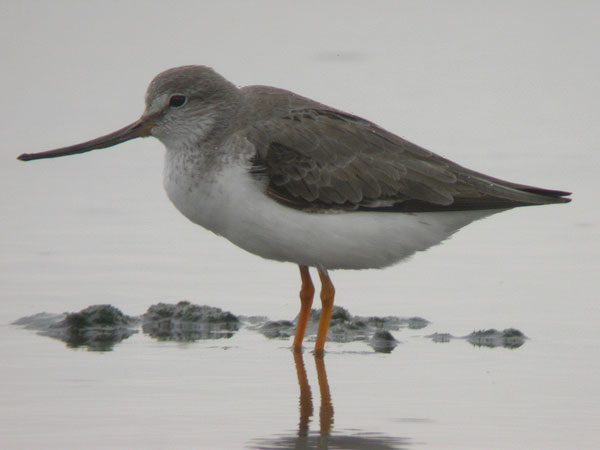 Terek Sandpiper |
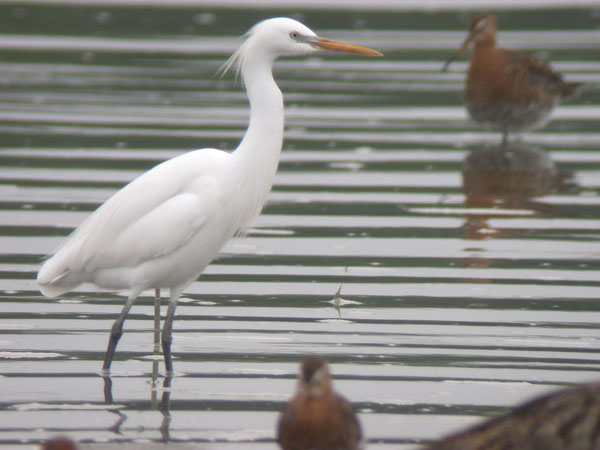 Swinhoe's Egret |
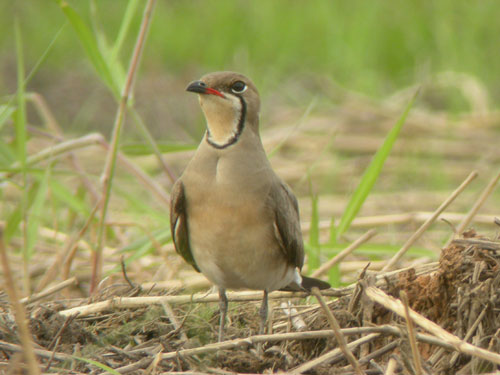 Oriental Pratincole |
|
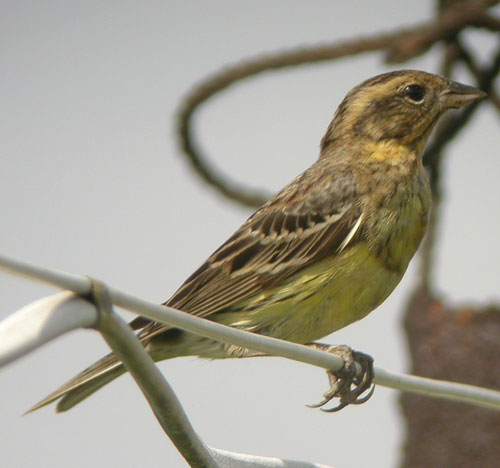 Yellow-breasted Bunting |
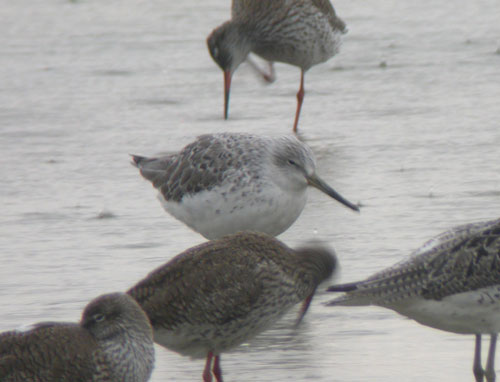 Nordmann's Greenshank |
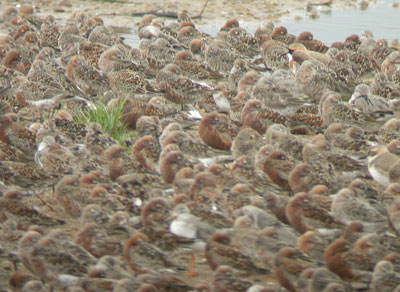 Curlew Sandpipers |
|
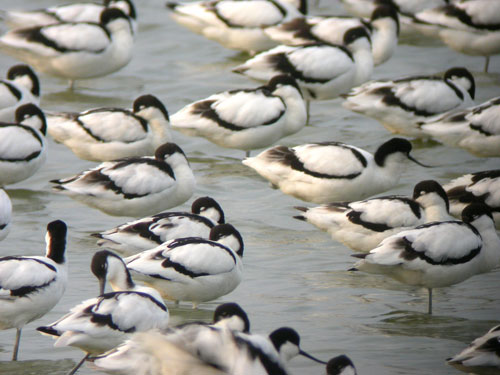 Avocets |
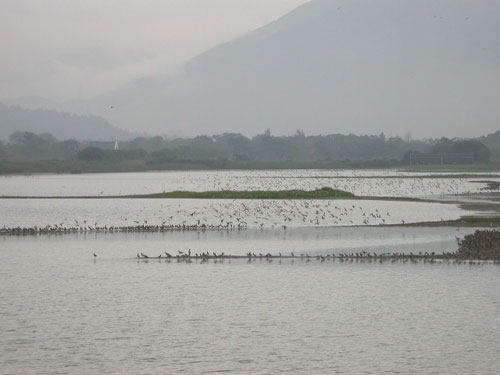 Waders at Mai Po |
||
This trip report summarises a 16-day birding visit to Hong Kong, based at the WWF Mai Po Nature Reserve in April/May 2006. I struggled to find much information on the website regarding bird trips to this part of the world prior to my departure so I hope future visitors will find this report useful.
Mai Po
Mai Po Nature Reserve is part of the 1,500 hectare Mai Po Inner Deep Bay Ramsar Site, lying in the north western part of the Hong Kong Special Administrative Region. It consists of a series of shrimp ponds (called gei wai) and fish ponds and is one of the last remaining areas in Asia where traditional shrimp farming still occurs. It has one of the largest reedbeds in the Guangdong Province and contains the sixth largest protected stand of mangroves in China. The Deep Bay estuary and network of pools and scrapes at Mai Po are home to 55,000 wintering waterfowl (12 of these such as Spoon-billed Sandpiper, Nordmann’s Greenshank and Black-faced Spoonbill are listed as endangered) and of course the passage of waders in spring have made this area a household name globally. Fortunately for me, one of the key reserve staff there, Bena Smith is a family friend so I had a better introduction to the reserve than most – but all the staff there were very welcoming and helpful and there is a good trail guide available (HK$1) from the Visitor Centre showing all the hides and walkways.
Getting there
I took a flight from Heathrow with Qatar Airways for the relatively cheap fare of £325.00. “Cheap” I suppose as it involved a 5-hour break at Doha between flights and a total travelling time of 22 hours but you can fly direct if you pay more. From the airport on Lantau Island you take a double-decker bus to Yuen Long (E34) which takes about 75 minutes (and costs about £1). A number of buses connect from there eg. Public Light Bus (red) No 17 from Shui Che Kwun Street or from Sun Fat Street, Sheung Shui to Mai Po village where a 15 minute walk will take you to the reserve Visitor Centre. However, as taxis are so cheap it isn’t worth the hassle so take a taxi to the doorstep once you’ve arrived in Yuen Long for about HK$50.
Getting around
Public transport in Hong Kong boasts to be the best in the world – and they are right. I took taxis, buses, trains (called the KCR network – Kowloon and Canton Railway) and the underground rail network (called MTR – Mass Transit Railway), all cheap, fast and efficient. You don’t need a hire car and in fact there are relatively few vehicles on the roads (which are also excellent), most of them appear to be new Mercedes. Get yourself an Octopus card from any convenience store, KCR or MTR station and keep it topped up at the stores or stations etc. This will allow you to travel on the trains, most buses and pay for food as well – cash rarely ever changes hands in Hong Kong! For some of the Public Light Buses small change is recommended such as $5 coins or $10 notes.
Money
Hong Kong dollars and the rate of exchange was £1 = $HK13.16 at home but $15.00 there. I used to keep my Octopus card topped up with a $HK100 note and it lasted ages considering how often I used it. With the favourable exchange rate there has probably never been a better time to go.
Food
This was a birding trip and after a 14-hour day in the field, followed by a shower and an hour to do my log, food wasn’t high on my agenda so I’m not the best person to speak on its behalf. I mostly ate in back at my digs but when I did eat out the food was good, cheap… and very different to home. I’m sure ‘normal’ people would say it’s fantastic but I was always too tired to enjoy it!
Weather
Oddly the daily weather reports would say it was only 21-25 degrees but I think the Met station is in mist on top of a hill. Certainly at sea level it felt more like >30 degrees most days, the heat increasing towards the end of my stay. The humidity reports seemed correct @ about 98%. May sees the start of their monsoon, rainy season and I felt a little uneasy walking around at Mai Po during thunderstorms with my scope and tripod (=lightning conductor) strapped to my back. I got wet most days but you soon dry out.
Visiting Mai Po
The Mai Po NR is a restricted area and in order to minimise disturbance you need to have a valid Mai Po Entry Permit issued by the Agriculture, Fisheries and Conservation Department of the Hong Kong SAR Government. A second separate permit issued by the Hong Kong Police is also required to access the inter-tidal mudflat areas because they lie inside the Closed Area between Hong Kong and Mainland China.
The process to obtain personal permits can be lengthy (up to 8 weeks!), so it is best to book a day permit through WWF Hong Kong. This can be done through the internet on the Mai Po section of the WWF website http://www.wwf.org.hk/eng/maipo where in fact a considerable amount of information can be found about the site such as directions, wildlife, public visit programmes, etc. WWF Hong Kong has a set quota of permits so apply at least three weeks ahead of your visit.
As Mai Po Nature Reserve is managed by WWF Hong Kong on behalf of the Hong Kong SAR Government, you need to join up as a WWF Hong Kong member before you can use the hides and boardwalks in the Reserve. You can get more details about how to join through WWF Hong Kong’s website http://www.wwf.org.hk/eng/involved/membership/index.html
The best birding at Mai Po occurs when the tide in Deep Bay is at or above 2.0m. Tidal heights between 2.0-2.2m bring the waterbirds within 5-30m of the floating hides. Tides greater than 2.2m will push the birds into the main Reserve onto gei wai #11 and #16/17, both of which are managed as high tide roosts. Hides at both gei wai provide fantastic views of the birds. When the tide recedes again and is around 2.2m it is worth heading back out to the floating mudflat hides. Tidal information can be found posted in the window of the Mai Po shop or to help plan your trip in advance go to the Hong Kong Observatory website http://www.hko.gov.hk/tide/eTBTtide.htm (Tsim Bei Tsui tidal station).
Accommodation
I stayed at the Peter Scott Field Studies Centre (PSFSC), Mai Po Nature Reserve, San Tin, Yuen Long, New Territories, Hong Kong. The PSFSC Visitor Centre is open daily 0900 – 1700hrs. The accommodation is owned and operated by WWF Hong Kong and conveniently located 3 minutes from the Mai Po Nature Reserve entrance. The PSFSC has showers, a good library (leave your Helm Shorebirds guide at home!), communal area with TV and DVD player, towels, linen and mosquito nets all provided. Rooms are air conditioned with your own fridge. The staff are all very friendly and I thoroughly enjoyed my stay there. To use the accommodation you must first be a member of WWF (Hong Kong) and this can be arranged when you arrive for around HK$300. Details and booking of the PSFSC accommodation can be found through the WWF website.
References and bird news
I took The Birds of Hong Kong and South China by Viney et al with me but you can buy this (and other items) from the Mai Po Visitor Centre if you prefer. There is a bird information service in English (2667 4537) which I used every day (you can leave messages for others to hear what you have seen) if only to get a flavour of what was around – we didn’t twitch anything but it was useful to know what others were seeing. There is a very good website, http://www.hkbws.org.hk which I used before and after my visit and the photos in the BBS Photo Gallery are simply wonderful, the standards set must rate one of the highest on the planet! There are relatively few birders in Hong Kong and most days I hardly met anyone in the hides at Mai Po. There are, however, a lot of bird photographers, probably a reflection of the lower prices for optical equipment there, and the photos they take are amazing. I was embarrassed to compare my digiscoping efforts when they were around and kept my camera out of sight!
Since October 2005, WWF Hong Kong regularly posts a summary of the birding highlights seen at Mai Po Nature Reserve http://www.wwf.org.hk/eng/maipo/birdrecord and this is useful to know what was seen the previous year. I am told that the Mai Po bird records page is being developed later in 2006 to include WWF bird reports and results from their monthly counts. The HKBWS is responsible for a lot of the bird monitoring on the Ramsar site and reports can be downloaded at http://www.hkbws.org.hk/waterbird/report.html.
Acknowledgements
Bena Smith, Reserve Officer at Mai Po is a close family friend and sorted out all my birding, accommodation and travelling arrangements. Bena took time off to introduce me to Mai Po the first week and we spent the whole of the second week birding together both at Mai Po and elsewhere. Thanks Bena! Thanks also to Dr Lew Young and his staff at the reserve especially Katherine, Eva and Ah Mun. John Allcock helped with forest birding at Tai Po Kau and welcomed me to his ringing site at Kam Tin. John Holmes gave me photos of many of the birds we saw together, but more importantly helped in the final minutes with buying postcards and presents on my behalf – thanks John you saved my life! Finally to all the others I met, especially on the HKBWS pelagics, who helped identify the birds for me and met my negative replies for ‘evenings out on the town’ with such understanding.
Itinerary
23 April Lantau Island to Mai Po
24 April Mai Po & Long Valley
25 April Mai Po & Tai Po Kau
26 April Mai Po
27 April Mai Po
28 April Mai Po
29 April Mai Po & Kam Tin
30 April Tai Po Kau, Kowloon Park, Kowloon & The Peak, Hong Kong Island
01 May Mai Po & Long Valley
02 May Pelagic in South China Sea & visit to Po Toi island with Hong Kong Bird Watching Society (HKBWS).
03 May Mai Po
04 May Lamma Island
05 May Pelagic in South China Sea & visit to Po Toi island with HKBWS.
06 May Tung Ping Chau
07 May Mai Po (access road ponds only) & Tai Mo Shan
08 May Mai Po
The Birding
Long valley (list combined for both half-day visits)
Mix of agricultural fields, abandoned land and fish ponds at Sheung Shui a short drive north-east of Mai Po. Most of lowland Hong Kong has been reclaimed so this area is unusual and one of the last remnants of lowland agriculture. The skyscrapers of Shenzhen on adjacent mainland China tower above it to the north.
Great White Egret 2, Intermediate Egret 1, Little Egret 15, Cattle Egret 50, Chinese Pond Heron 25, Cinnamon Bittern 1, Black Kite 4, Bonelli’s Eagle 1 both visits, Hobby 2, Greater Painted-snipe Adult with pullus a few days old, Little Ringed Plover 1, Black-winged Stilt 1, Wood Sandpiper 20, Common Sandpiper 4, Pintail/Swinhoe’s Snipe 3, Common Snipe 6, Red Turtle Dove 3 (male 2 females 24th), Spotted Dove 40, Large Hawk Cuckoo 2, Indian Cuckoo 3, Plaintive Cuckoo 2, Common Koel 3, Greater Coucal 1, House Swift 30, Pied Kingfisher 1, Barn Swallow 30, Yellow Wagtail c100, White Wagtail 2, Richard’s Pipit 4, Red-whiskered Bulbul c60, Chinese Bulbul 20, Sooty-headed Bulbul 4, Long-tailed Shrike 24, Brown Shrike 1, Oriental Magpie Robin 12, Siberian Stonechat 1, Masked Laughingthrush 15, Yellow-bellied Prinia 20, Plain Prinia 10, Common Tailorbird 1, Dusky Warbler 4, Great Tit 2, Japanese White-eye 3, Little Bunting 2, Yellow-breasted Bunting 5, Scaly-breasted Munia 4, Tree Sparrow c100, Black-collared Starling 30, White-shouldered Starling 5, Crested Myna 15, Common Myna 1, Black Drongo 4, Common Magpie 3, Azure-winged Magpie 2, Collared Crow 5.
Tai Po Kau (list combined for both half-day visits)
Hill forest with a good network of trails well marked. 15km south-east of Mai Po. Bena and I walked the red and blue trails. Missed Fairy Pitta, Forest Wagtail, Orange-headed Thrush, (probably heard it singing!), Mountain Bulbul and goodness knows what else. We saw or, more correctly, heard the following:
Black Kite 4, Crested Serpent Eagle 1, Crested Goshawk 1, Chinese Goshawk 1, Spotted Dove 2, Emerald Dove 1, Pacific Swift 1, House Swift 10, Great Barbet 2, Barn Swallow 3, Common Koel 1, Grey-throated Minivet 3, Scarlet Minivet 4, Grey-thr/Scarlet Minivet another 12 unidentified, Red-whiskered Bulbul 55, Chinese Bulbul 9, Chestnut Bulbul 9, Oriental Magpie Robin 20, Rufous-capped Babbler 10, Laughingthrush sp? 2 heard, Pygmy Wren Babbler 6: the first ever Hong Kong record was here as recently as Feb. 2000!, Masked Laughingthrush 30, Black-throated Laughingthrush 2, Silver-eared Mesia 7, Blue-winged Minla 2, White-bellied Yuhina 2, Common Tailorbird 6, Mountain Tailorbird 1, Dusky Warbler 1, Yellow-browed Warbler 1, Hainan Blue Flycatcher 2, Japanese Paradise Flycatcher 1, Great Tit 4, Yellow-cheeked Tit 1, Velvet-fronted Nuthatch 3, Scarlet-backed Flowerpecker 2, Buff-bellied Flowerpecker 1, Fork-tailed Sunbird 6, Japanese White-eye 30, Tree Sparrow 10, Black-collared Starling 5, Crested Myna 2, Black Drongo 2, Magpie 6, Large-billed Crow 4.
Kam Tin
Another lowland agricultural area only 6km south of Mai Po but threatened with development (infilling encroachment from all sides apparent when I was there). John Allcock is championing the site and undertaking ringing there and monitoring Greater Painted-snipe (which may breed). There are too few areas like this left in Hong Kong. The only place now for Grey-headed Lapwing.
Grey Heron 1, Little Egret 1, Cattle Egret 50, Chinese Pond Heron 2, Black Kite 2, Crested Serpent Eagle 3, Greater Painted-snipe 1, Grey-headed Lapwing 3, Wood Sandpiper 3, Common Sandpiper 1, Pintail/Swinhoe’s Snipe 3, Common Snipe 2, Oriental Turtle Dove 6, Spotted Dove seen, Indian Cuckoo 6, Plaintive Cuckoo1, Common Koel 2, Greater Coucal 2, Pacific Swift 1, House Swift 80, Bee-eater sp (probably Blue-tailed) 4, Sand Martin 2, Barn Swallow 20, Yellow Wagtail 20, Grey Wagtail1, White Wagtail 2, Richard’s Pipit 10, Red-whiskered Bulbul seen, Chinese Bulbul seen, Brown Shrike 1, Long-tailed Shrike 2, Oriental Magpie Robin seen, Siberian Stonechat 1, Black-browed Reed Warbler 1, Oriental Reed Warbler 1, Yellow-bellied Prinia seen, Japanese White-eye 2, Tree Sparrow seen, Red-billed Starling 5, White-cheeked Starling 2, White-shouldered Starling 4, Crested Myna seen, Common Myna 5.
Kowloon Park and ‘The Peak’, Hong Kong Island
A leafy oasis in the middle of bustling Kowloon with various ‘exotics’ now firmly established. Bena and I spent an hour or so there en route to ‘The Peak’ on 30th and saw an Arctic Warbler. Doubtless good for other migrants.
Black Kite 50, Oriental Turtle Dove 1, Yellow-crested Cockatoo 3, Rose-ringed Parakeet 1 Hong Kong Park, Alexandrine Parakeet 2 pairs visiting nest holes KP, Red-whiskered Bulbul seen, Chinese Bulbul seen, Oriental Magpie Robin seen, Masked Laughingthrush 2, Arctic Warbler 1, Japanese White-eye 1 on nest, Red-billed Starling 2 pairs KP (of which one obviously nesting in eaves of roof on edge of park), Black-collared Starling 4, White-shouldered Starling 4, Black Drongo 1.
South China Sea pelagics
This is a new venture for the HKBWS and their day trips are re-writing the text books! Bena and I were lucky to be invited on two of these: 2nd and 5th May. Both were full-day pelagics (but no chumming) meeting 0800hrs Quarry Bay, Hong Kong Island and sailing south-east down the Tathong Channel then around the Ninepin Island Group before berthing at Po Toi in the south for a 90 minute lunchtime break. We then sailed south to the edge of Hong Kong waters then back north west round Lamma island to dock at Aberdeen, Hong Kong Island 1700-1800hrs.
On 2nd we saw: Short-tailed Shearwater at least one – the 4th record for Hong Kong!, Pacific Reef Egret on Lamma, Black Kite 100, White-bellied Sea Eagle adult caught a sea snake off Junk Bay and was well photographed by John Holmes, Red-necked Phalarope 231, White-winged Tern 222, Common Tern 6, Black-naped Tern 7, Aleutian Tern 8, Bridled Tern 9, Sooty Tern juvenile (well photographed by John Holmes luckily – it would have got away otherwise) flew past with 3 Bridled – the 6th record for Hong Kong!, Brown Hawk Owl 1 flew north over the boat at sea!
On 5th we saw: Short-tailed Shearwater another 8!, Streaked Shearwater 20, Red-necked Phalarope 595, Whiskered Tern 2, White-winged Tern 50, Caspian Tern 7, Common Tern 12, Black-naped Tern 56, Aleutian Tern 54, Bridled Tern 9, Greater Crested Tern 3, Aleutian/Common Tern 20, Unidentified tern sp? 72, Unidentified skua sp? 2, Pomarine Skua 6, Arctic Skua 6 (The first record for Hong Kong was only as recent as May 1999), Long-tailed Skua 11, another Brown Hawk Owl migrating north at sea!, Pacific Swift 1, Barn Swallow 1.
Po Toi Island (list combined for both half-day visits)
The ‘Fair Isle’ of Hong Kong? Local birder Geoff Welch who has booked a house in the village for a month this year has certainly put the island on the birding map this spring. Read all about Geoff’s sightings on the HKBWS website already mentioned. We only spent three hours in total there but even so I managed to miss a White’s Thrush, Lanceolated Warbler and a Savanna Nightjar in that time!
Pacific Reef Egret 3, Cattle Egret 5 with 7 Chinese Pond Herons migrating high over the island on 2nd, Black Kite 7, Chinese Goshawk 1, Common Koel 2, Barn Swallow 1, Grey Wagtail 1, Ashy Minivet 1, Red-whiskered Bulbul 6, Chinese Bulbul 8, Brown Shrike 5, Oriental Magpie Robin 1, Blue Whistling Thrush 1, Masked Laughingthrush 2, Grey-streaked Flycatcher 3, Arctic Warbler 2, Japanese White-eye 9, Crested Myna 10, Tree Sparrow seen, Black-collared Starling 4, Black Drongo 3, Large-billed Crow 1.
Lamma Island
Hoping to mirror Geoff’s successes on Po Toi, Bena and I visited this (much larger) island to the north west on 4th and spent seven hours scouring the woods but the best we came up with were 2 Dollarbirds and a few Chinese Goshawks migrating north.
Grey Heron 1, Little Egret 18, Pacific Reef Egret 3, Cattle Egret 1, Chinese Pond Heron 1, Black Kite 56, White-bellied Sea Eagle 2, Crested Goshawk 1 displaying, Chinese Goshawk 7 north and another in area, Peregrine 1, Chinese Francolin 3, White-breasted Waterhen 5 adults and 1 pullus, Black-winged Stilt 3, White-winged Tern 33 north, Black-naped Tern 20 on crossing, Spotted Dove 36, Large Hawk Cuckoo 2, Indian Cuckoo 3, Common Koel 2, Greater Coucal 5, Pacific Swift 17, House Swift 17, White-throated Kingfisher 4 including one outside cliff nesting-hole, Dollarbird 2, Barn Swallow 34, Yellow Wagtail 3, Grey Wagtail 1, Red-whiskered Bulbul 82, Chinese Bulbul 35, Sooty-headed Bulbul 1, Oriental Magpie Robin 29, Hwamei 4, Long-tailed Shrike 1, Yellow-bellied Prinia 6, Common Tailorbird 9, Fork-tailed Sunbird 1, Japanese White-eye 55, Scaly-breasted Munia 3, Tree Sparrow 15, Black-collared Starling 8, Crested Myna 60, Black Drongo 18, Common Magpie 2, Large-billed Crow 4, Collared Crow 2 on nearby Little Green Island amongst colony of Cattle Egrets.
Tung Ping Chau Island
Our last chance to emulate Geoff’s success on Po Toi. We failed. Nevertheless a good island to cover in a day and relatively flat if a little too much cover to find anything easily. Situated in the far north east it may be better in autumn - but for the fact mainland China is in the way.
Great White Egret 1, Chinese Pond Heron 1, Black Kite 5, White-breasted Waterhen 2, Common Sandpiper 1, Red-necked Phalarope 1, White-winged Tern 50, Bridled Tern 2, Spotted Dove 9, Indian Cuckoo 2, Common Koel 1, Greater Coucal 6, White-throated Kingfisher 1, Barn Swallow 4, Red-whiskered Bulbul 19, Chinese Bulbul 27, Brown Shrike 4, Oriental Magpie Robin 10, Yellow-bellied Prinia 1, Common Tailorbird 4, Arctic Warbler 1, Great Tit 5 including recently fledged juvenile, Grey-streaked Flycatcher 4, Japanese White-eye 4, Black-collared Starling 1, White-shouldered Starling 1, Crested Myna 27, Black Drongo 9, Common Magpie 1, Large-billed Crow 3.
Tai Mo Shan
At 957m above sea level this is Hong Kong’s highest peak. Often covered in mist (as it was when we arrived) when the skies clear you have fantastic views across the islands and this is the best place to find the upland species in the archipelago. We drove up the (good) road as far as the barrier just below the peak, parking in the small car park there.
Chinese Francolin 7 heard, none seen!, Indian Cuckoo1, Common Koel 1, Greater Coucal 2, Lesser Coucal 1, House Swift 2, Barn Swallow 2, Richard’s Pipit 3, Upland Pipit 1, Sooty-headed Bulbul 2, Chestnut Bulbul 2, Siberian Rubythroat – a cracking male on rocks was very late (latest ever was 10th May 1980), Blue Whistling Thrush 2, Streak-breasted Scimitar Babbler 2, Hwamei 6, Red-billed Leiothrix 2, Vinous-throated Parrotbill 2 (the only site in Hong Kong for this), Russet Bush Warbler only heard, Brownish-flanked Bush Warbler 9 but only heard, Large Grass Warbler 2 pairs feeding young, Yellow-bellied Prinia 15, White-rumped Munia 2.
Mai Po
Saving the best to last…Mai Po is paradise on Earth for a European birder! When I stepped into Hide No. 7 (there are ten in all) overlooking the scrape on my first morning and opened the shutter to gaze at the waders coming in on the tide it was the closest I’ve ever come to crying in my birding life! I had never before seen such a variety of waders anywhere – or had such good close views; too many to list here but the highlights on that day for me were the Greater & Lesser Sandplovers, Far-eastern Curlew, Oriental Pratincole, 30 Marsh Sands mingled amongst the Greenshank, Redshank and Spotted Reds, 50 Tereks, 5 Grey-tailed Tattlers, Asiatic Dowitchers amongst the Black-tailed Godwits, Great Knots and Red-necked Stints, 3 Sharp-tailed Sandpipers, flocks of Avocets and Black-winged Stilts, Red-necked Phalaropes spinning in the water and 400 Curlew Sandpipers in breeding plumage. And this proved to be a quiet day subsequently!
Little Grebe Up to 20/day.
Grey Heron Up to 20 most days but 35 on 27th.
Purple Heron 2-3 seen occasionally
Great White Egret Daily. Up to 40.
Intermediate Egret Recorded most days with max. 15 on 27th.
Little Egret The commonest egret. Up to 200/day though often less.
Swinhoe’s Egret Two birds seen from the boardwalk hides, Deep Bay.
Cattle Egret Daily, up to 60.
Chinese Pond Heron Breeds in trees at the Visitor Centre. Up to 50/day.
Striated Heron 1-2 several days with 5 on 8th.
Black-crowned Night Heron Daily, usually 30-40/day.
Yellow Bittern Recorded 4 dates with max. 4 on 26th.
Eurasian Spoonbill One amongst the Black-faceds on 24th.
Black-faced Spoonbill Peak count of 76 on 25th was rather high for the time of year.
One of these with ring K47 had been ringed as a chick in Korea.
Eurasian Wigeon 28 on 25th was the peak count.
Common Teal Up to 3.
Mallard Single bird only 27th.
Spot-billed Duck At least three birds present.
Garganey 14 on 25th was the peak count.
Northern Shoveler 4 on 26th but only 1 by 28th.
[Falcated Duck Drake on 25th had arrived some weeks earlier but as it had a tag on
one of its legs was presumably an escape]
[Scaup Adult drake on unlikely (late) dates of 25th-29th April was
presumably an escape]
[Tufted Duck Single bird 29th April variously reported as a Baer’s Pochard or
Ferruginous Duck showed characters of a Tufted hybrid and was assumed to be an escape also.]
Osprey Most days. Up to 3.
Black Kite The commonest raptor in Hong Kong. Up to 10/day here.
White-bellied Sea Eagle A pair chasing a Black-headed Gull (which got away) around
Deep Bay on 27th watched from the boardwalk hide.
Eurasian Hobby Single bird at dusk along the access road on 23rd.
Peregrine Falcon Adult most days.
White-breasted Waterhen Up to 8/day.
Common Moorhen Up to 30/day.
Eurasian Coot single bird to 27th.
Greater Painted-snipe A pair on the main scrape on 27th.
Black-winged Stilt Up to 80. Breeding at Mai Po.
Pied Avocet Daily. Count of 620 on 3rd. I photographed a pair nest building
@ the main scrape in front of No.5 hide (see photos in the Photo Gallery pages on the HKBWS website). Apparently, this is the first documented proof of attempted nesting in Hong Kong. Quite an appropriate find seeing as I work for the RSPB!
Oriental Pratincole 1-3 on five dates but 5 birds as late as my last day, 8th May.
Pacific Golden Plover Recorded 5 dates with max. 7 on 26th.
Grey Plover Peak counts of 150 26th and 200 on 27th diminished to 30 by 28th
and only 8 by 3rd May.
Little Ringed Plover 2-3 pairs. Suspected breeding at two sites.
Kentish Plover 3 on 24th & 25th with 2 on 3rd.
Lesser Sand Plover Max count of 4 on 28th but I suspect I overlooked some amongst
the commoner Greaters.
Greater Sand Plover Daily. Peak count 169 on 28th.
Black-tailed Godwit Daily. Peak count 150 on 27th.
Bar-tailed Godwit Only two birds: 24th April & 1st May.
Whimbrel Peak counts 46 on 28th & 72 on 3rd.
Eurasian Curlew 20-35 most days.
Far-eastern Curlew 2 on 24th then 1 until 27th.
Spotted Redshank Daily. Counts of 300 27th & 28th with 640 on 3rd.
Common Redshank Daily. Peak count of 800 on 29th.
Marsh Sandpiper Daily. 120 on 27th & 28th were the highest counts.
Common Greenshank Daily. 300 26th & 27th with 600 28th.
Nordmann’s Greenshank 2 on 27th and 1 28th & 2nd but I’m sure I overlooked others
amongst all the Greenshanks.
Green Sandpiper Singles (same bird?) 24th & 25th only.
Wood Sandpiper 80 on 24th then an obvious decline with 6 on 27th but increasing
again to 26 on 3rd.
Terek Sandpiper Daily with highest counts of 364 on 28th and 190 3rd.
Common Sandpiper Daily 8-14/day but peak of 28 on 29th. Decline thereafter.
Grey-tailed Tattler recorded all visits to high tide roosts/Deep Bay area with 15 on
26th, 10 27th, 71 28th and 12 3rd the highest counts.
Ruddy Turnstone 15 24th & 27th with 25 on 26th and 26 on 28th. Only 7 by 3rd May.
Red-necked Phalarope Usually just 1-3 but in poor weather on 3rd May there were an
estimated 710 in Deep Bay, counted from the boardwalk hide.
Pintail/Swinhoe’s Snipe Singles 29th & 1st May.
Common Snipe 2 24th, 5 28th, 2 29th and 1 1st.
Asian Dowitcher Recorded six dates (up to 7/day) with highest count 23 on 3rd May.
Red Knot Seen on 5 dates 24th-3rd but no more than 4/day.
Great Knot 3 24th, 6 26th, 5 27th and 2 28th.
Sanderling 4 24th, 10 26th, 8 27th, 17 28th and 2 3rd.
Spoon-billed Sandpiper No. Apparently one before I arrived and another after I left but I
don’t want to talk about them.
Red-necked Stint Recorded all high tide visits with max. 300 26th declining to 55 3rd.
Long-toed Stint 2 23rd, 6 24th, 3 28th and 8 3rd.
Sharp-tailed Sandpiper 3 24th, 10 26th, 8 27th, 6 28th and 2 on 3rd.
Curlew Sandpiper Daily with peak count of 2500 27th but 1000 next day falling to
only 20 by 1st May.
Broad-billed Sandpiper Up to 7/day on 5 dates 25th-1st but 49 on 3rd May (at scrape and
later Deep Bay on falling tide)
Black-headed Gull 11 Deep Bay 26th was the highest count. Only two (at the scrape)
remained by 8th May.
Whiskered Tern 2 26th, 1 27th and 5 28th.
White-winged Tern 2 27th, 10 28th April. 4 1st May but then in heavy rain on 3rd we
counted 522 feeding and roosting in Deep Bay from the boardwalk hide.
Gull-billed Tern Recorded most days with peak count 65 on 26th.
Caspian Tern Highest count was 13 on 28th. Otherwise 1-8 most days.
Common Tern Single feeding in Deep Bay from boardwalk hide on 28th in poor
weather was unusual apparently.
Little Tern 5 26th and 4 3rd from boardwalk hide in Deep Bay.
Feral Pigeon Daily.
Oriental Turtle Dove Singles 25th, 27th and 29th.
Spotted Dove Daily: c20/day.
Chestnut-winged Cuckoo Single calling at the Visitor Centre on 7th May.
Indian Cuckoo 2-3 most days.
Plaintive Cuckoo Daily. 1-2 plus a hepatic female seen two dates.
Common Koel Daily. Up to 15/day.
Greater Coucal Daily. 4-8/day.
Pacific Swift Singles 29th April & 3rd May.
House Swift Daily in small numbers usually <20.
Pied Kingfisher Daily. Up to 7/day.
Common Kingfisher Daily. 3-4.
Blue-tailed Bee-eater Flocks of 9 27th April and 8 3rd May.
Sand/Pale Martin Daily. Most were probably Sand Martins but some individuals
looked pale and long-winged when perched. Mostly present around the fish pools at the access road with highest counts 140 on 29th April and 178 3rd May.
Barn Swallow Daily. 20-80 most days.
Red-rumped Swallow Single at fish pools, access road on 3rd May.
Yellow Wagtail Daily. 3 different races identified (Green-headed M.f.taivana, Eastern M.f.tschutschensis and Manchurian M.f. macronyx) with the highest counts 350 29th April (the majority roosting in the reedbeds at dusk) and 380 flying north 3rd May.
White Wagtail Daily. 4-6.
Richard’s Pipit 1-3 birds only. Race here is the (small) A.r.sinensis.
Red-whiskered Bulbul Daily. Common but less so than Chinese.
Chinese Bulbul. Common e.g. 40 27th.
Brown Shrike Single of race L..c.lucionensis on 28th April.
Long-tailed Shrike Up to 4/day.
Siberian Rubythroat Late singing male on 26th April near tower hide.
Oriental Magpie Robin Daily. Common and widespread.
Masked Laughingthrush Most days: up to 10/day.
Oriental Reed Warbler Up to 4/day but not seen every day.
Zitting Cisticola A late bird on 29th April.
Yellow-bellied Prinia Common and widespread.
Plain Prinia Common and widespread.
Common Tailorbird 3-4 most days.
Dusky Warbler Singles 25th, 27th, 28th April and 1st May.
Asian Brown Flycatcher Singles (same bird?) 29th April & 1st May.
Great Tit 1-2 pairs most days.
Japanese White-eye Common and widespread. Up to 20/day.
Yellow-breasted Bunting Good numbers at the access road pools where 81 were counted
on 29th (many stopping only briefly then carrying on north) – a high count apparently in recent years. Single there 1st & 3 on 3rd.
Black-faced Bunting Male on 29th was the only one of the trip.
Scaly-breasted Munia Small flocks noted many days with 30 on 29th the highest count.
Eurasian Tree Sparrow Common and widespread.
Red-billed Starling 1 flew over access road pools on 3rd May.
White-cheeked Starling 2 on 24th April access road.
Black-collared Starling Daily. Up to 40/day but usually fewer.
White-shouldered Starling Daily in small numbers, never >5/day.
Common Myna A pair seen occasionally access road with 3-4 juveniles there 7th.
Crested Myna Common and widespread. 20-30/day.
Black Drongo Daily in small numbers, never >6/day.
Blue Magpie Unusually one was seen well on 7th (and then I had another at the
airport as I was leaving the following day).
Common Magpie Daily. Up to 8/day.
Azure-winged Magpie Only seen at the Visitor Centre - where about a dozen show well
every day.
Collared Crow Daily. The birds roost at the southern end of the reserve and I
counted 30 there on 29th.
Total number of bird species seen (all sites): 189.
Dave Flumm - 26th May 2006.